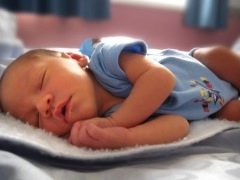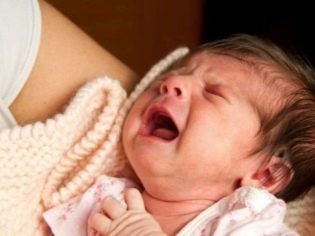Why does the baby arch his back and throw back his head?
If the baby arches his back and throws back his head, the parents cannot remain indifferent. What this baby’s behavior says, whether it’s dangerous and what to do, we will tell in this material.
Physiological causes
The reasons for the strange posture, which in medicine is often called the “acrobatic bridge,” can be completely natural, do not pose any danger to the child, and are not a cause for parental anxieties.
During pregnancy, the baby was in cramped conditions - in the uterus it was not possible to turn around, stretch the limbs, especially in the later stages. Kids simply get used to the “compact” pose, and the first 2-3 months of extrauterine life adapt to the new conditions in which you can stretch the legs and arms as you like. From this point of view, it is quite understandable why a newborn can take rather strange postures in a dream, including bending the back.
Increased muscle tone is also quite natural for an infant, and therefore arching the back with the head tilting back can be quite natural in the first months of life, provided that nothing else happens to the baby that would cause anxiety.
Often the back is bent by children whose parents are adherent to tight swaddling. Usually, with such postures, a baby can show that he is uncomfortable in a diaper, that his hands or legs are numb. After the babies are released from the diaper, he can happily bend and stretch.
Another fairly common reason for this behavior is the expression of feelings and emotions. A baby in its arsenal doesn’t have many tools to express its feelings and desires - cry and posture. If crying does not cause a lightning reaction of the parents, the child will report a wet diaper, hunger or pain by increasing the scream while simultaneously bending the back and drooping the head.
By bending the body, the baby can show that he is already ripe for a new position in space, that he is bored of lying on his back and that he is already ready for coups on his stomach. Typically, such physiological flexion begins at the age of 4-5 months, if the baby has not yet begun to roll over before this time.
Sometimes the reason lies in the banal habit - if the toys above the crib are not hung at the level of the baby’s tummy, but at the face level, the deflections will be quite common - so the crumb will try to visually track the movement of the toy in the mobile.
If a child is cheerful and active, if he eats well and sleeps normally, do not invent illnesses that he does not have. Episodic cases when the baby bends the back while lying on it or throws the head back in a dream or during the massage should not be a reason for panic.
However, abundant and frequent regurgitation, poor appetite, anxiety, muscle tension, even in sleep, the unnatural position of the arms and legs, which are difficult to dilute into a normal posture, in combination with arching the back, should alert the parents and make them see a doctor.
Pathological causes
Pathological causes of the phenomenon may be different.No doctor can tell you the true cause without a preliminary examination of the child, obtaining laboratory data, ultrasound data or other diagnostic methods. Let's look at the most frequent reasons why the baby arches the back and throws his head back.
Intestinal colic
Infant colic is quite common between the ages of birth and 3-4 months. They are associated with the establishment of bowel function, with the characteristics of infant meteorism and metabolism. Most often they appear when feeding and some time after feeding. If the child is in the hands of the mother, he presses the legs to the stomach and cries, alternating flexion with reflections (then bends, then bends).
The pains from the fermentation of intestinal gases are quite strong, so the kid can quite throw back the head, make a “bridge” in the supine position, scatter the handles in different directions and still scream. To understand that it is the fault of all the gases, it is enough to apply a warm diaper to your tummy, previously ironed by the iron, to give Simethicone or any preparation with its content that minimizes the amount of gas in the baby’s intestines. Usually it is warm and such drugs act within 15-20 minutes and the baby calms down. After waking up on an empty stomach, the little tot does not show any deflections, since the cramps do not occur before meals.
Rhinitis, cold, viral infection
Nasal passages in newborns are narrow, and therefore even a small rhinitis can block the child’s access to free breathing. Often infants who have a stuffed nose, throw back the head back, including in a dream. Parents need to pay attention to the accompanying symptoms - fever, snoring, coughing, refusal to eat.
The most pronounced will be throwing back and bending at the time of feeding, since the child cannot breathe freely in the nose and the mouth is occupied with the breast or the nipple.
Hypertonus
Muscle hypertonia is not considered an independent problem; it is also characteristic of perfectly healthy children in the first six months of life, and in children with disorders of the central nervous system. Independently understand the reasons will be difficult. I need the help of pediatricians and a neurologist for children's specialists.
Increased muscle tone is usually more stable, does not depend on feeding, sleep and other factors. In most cases, the tone with the harmonious development of the child and the normal care passes with time itself. Parents can help the child with a relaxing massage, bathing, walks in the fresh air, daily gymnastics.
If the cause is a disease of the musculoskeletal system, spine, muscular system, central nervous system, the doctor will prescribe the appropriate treatment.
Increased intracranial pressure
Quite often, parents can hear a similar diagnosis. However, modern pediatrics is not inclined to regard it as a separate ailment. Increased pressure inside the skull can be accompanied by a wide variety of diseases, including birth injuries, neurological disorders, hydrocephalus.
If a child constantly screams, doesn’t sleep much, eats poorly, spits up strongly, he is sluggish and is not interested in the surrounding world, noticeably lags behind his peers in development and often bends back and throws back his head, going in a scream, you definitely need to show him to a neurologist.
Concomitant symptoms of many pathologies associated with disturbances in the level of pressure inside the skull are strabismus, tremor of the limbs, pupils, tendency to convulsions, bluish nasolabial triangle. From the physiological deflections described above, these symptoms differ dramatically, to confuse them with colic or with the banal curiosity of a child who wants to roll over and cannot yet do so is very simple.
Opinion of Dr. Komarovsky
A well-known and respected mother among children, a children's doctor, Yevgeny Komarovsky, argues that there is no need to hurry with conclusions. In most cases, the child who bends the back when you take his hands, or the baby, who is bent in a supine position in certain circumstances, is quite healthy.
Cases of pathologies of the nervous and musculoskeletal systems are less common. Much more often, children are bent without serious reasons than they bring their parents a lot of mental suffering.
The doctor recommends taking a calm observant attitude. To note how often bending occurs, after which they occur (after eating, massage, gymnastics, swimming). Whether they disappear after satisfaction of the baby's requirements - they fed, dressed, coped with colic.
Naturally, medical consultations require such deflections, which occur involuntarily, for example, in a dream, if all the muscle groups of the baby are very tense and the mother cannot return the limbs or the head of the child to its normal position due to over-tension of the muscles.
A baby who arches a back while sitting or lying, doing it several times a day should be examined by a neurologist.
What to do?
As Komarovsky says, first of all you need to watch the child. If no other painful symptoms are found, then, in essence, nothing is required. Regular care with regular bathing, massage and gymnastics. If there are additional warning signs, it is better not to waste time and consult a doctor.
Independently at home, parents, in the process of observing a child, can address the removal of external factors that may be the cause of a child’s strange postures:
- Review the location of the crib, toys, transfer from the head of the head to the middle part of the crib everything that may be of interest to the child - rattles, mobile, etc.
- Give the child enough attention. (very often, babies with tantrums and whims not only achieve the elimination of sputum in the diaper or hunger, but also simply require communication with adults).
- Go swimming - It is possible to teach a child this at any age, starting from 1 month. Swimming in the bath or in the pool will help the muscle tissue to develop and grow more evenly, and faster, increased muscle tone will be removed.
- Do not panic - A calm mother can give a child much more to a child for his health and development than a hysterical person.
And finally, the most important advice. When visiting the doctor, do not rush to immediately express to him all your concerns. In Russia, there is an acute problem of overdiagnosis, when a healthy child, after her mother's complaints about strangeness, which, in her opinion, may be pathological, is prescribed a treatment that he, in fact, does not need.
An experienced doctor himself will pay attention if the child does have lesions of the nervous system or the musculoskeletal system. In this case, he will ask a lot of questions, to which mother will be able to answer most fully.
On the neurological problems in children will tell Dr. Komarovsky in the next video.


























